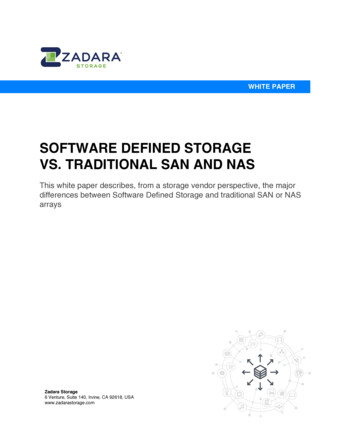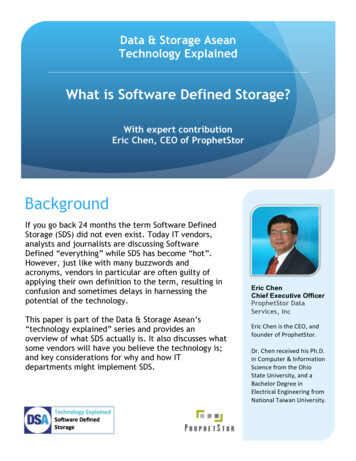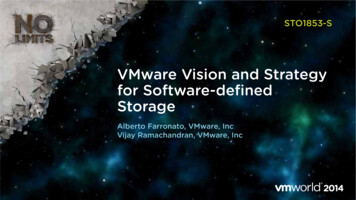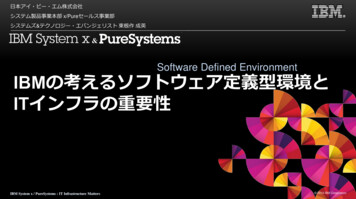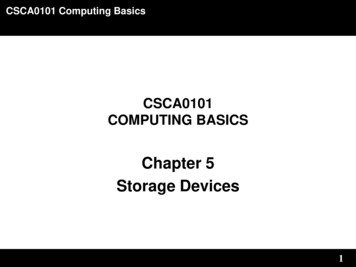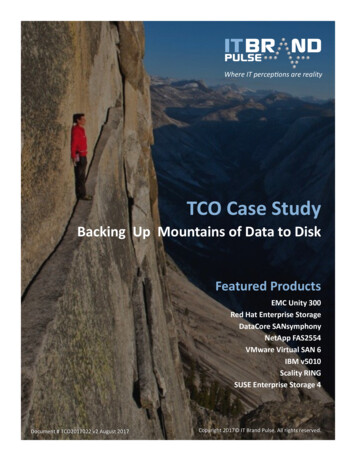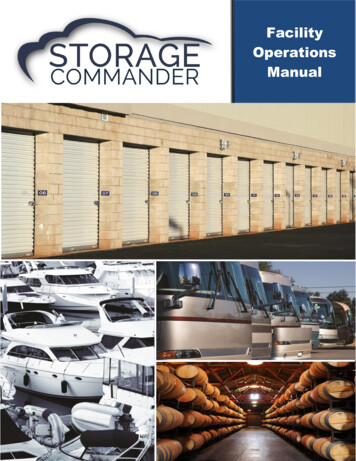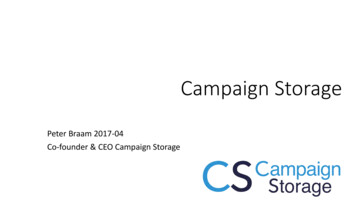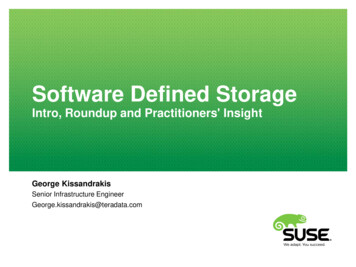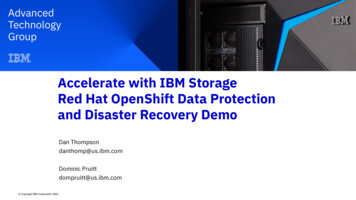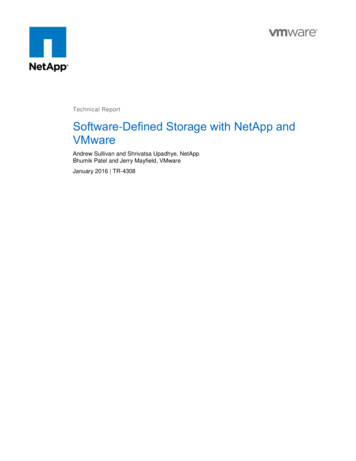
Transcription
Technical ReportSoftware-Defined Storage with NetApp andVMwareAndrew Sullivan and Shrivatsa Upadhye, NetAppBhumik Patel and Jerry Mayfield, VMwareJanuary 2016 TR-4308
TABLE OF CONTENTS12345672Joint Solution Overview . 51.1Summary.51.2SDDC Overview .51.3SDS Overview.61.4NetApp SDS in SDDC .71.5Automation and Orchestration in SDDC .9NetApp and VMware Solution Components . 102.1SDS with OnCommand WFA 3.1 .112.2OnCommand Unified Manager for NetApp Storage Management .122.3VMware vRealize Orchestrator .132.4VMware vRealize Automation 6.2 in SDDC with SDS .15Optional Component: Performance Monitoring and Problem Remediation Management . 223.1OnCommand Insight .223.2vRealize Operations .263.3Blue Medora vRealize Operations Management Pack for NetApp .283.4vRealize Log Insight .283.5NetApp vRealize Log Insight Content Pack .30Optional Component: Disaster Recovery in a NetApp and VMware SDDC Environment . 304.1NetApp SnapMirror .314.2VMware vCenter SRM .324.3NetApp SRA and SVMs .324.4Disaster Recovery in a NetApp and VMware SDDC Environment .32Terminologies and Functionality . 335.1NetApp and VMware SDS Overview .355.2Roles and Functionality .36NetApp SDS . 366.1NetApp SDS Overview .366.2SVMs .376.3NetApp Storage Technologies for Cloud Storage .376.4Accelerated Performance.39SDS Orchestration and Automation Workflows . 407.1Where to Begin with Your First Workflow .407.2Benefits .40Software-Defined Storage with NetApp and VMware 2016 NetApp, Inc. All rights reserved.
87.3Architecture Capabilities .417.4Understanding Workflow Concepts .417.5Security and Workflows .43Conclusion . 44References . 44Supporting Documents . 44Version History . 45LIST OF TABLESTable 1) Terminology and technology used in this document. .33Table 2) Workflow components. .43LIST OF FIGURESFigure 1) SDS overview.6Figure 2) SDDC layers. .8Figure 3) NetApp technologies for SDS.9Figure 4) SDS environment. .11Figure 5) OnCommand WFA 3.1 overview. .12Figure 6) NetApp WFA and vRealize Orchestrator in SDS.15Figure 7) Example service catalog (graphic provided by VMware). .17Figure 8) vRealize Automation uses update profiles to maintain consistency (graphic provided by VMware). .18Figure 9) Model new applications with existing services using external service (graphic provided by VMware). .19Figure 10) Services whose delivery can be automated through vRealize Automation (graphic provided by VMware). 20Figure 11) Advanced service designer workflow (graphic provided by VMware). .21Figure 12) vRealize Automation example configuration. .21Figure 13) NetApp and VMware SDDC solution with performance monitoring and management. .22Figure 14) NetApp OnCommand Insight visualization of complex storage environment. .23Figure 15) Bully workloads. .24Figure 16) Victim workloads. .24Figure 17) Capacity and performance data for NetApp devices. .25Figure 18) Dashboard showing capacity trending, forecasting, and performance. .26Figure 19) vRealize Operations in the cloud (graphic provided by VMware). .27Figure 20) Blue Medora vRealize Operations plug-in for NetApp storage. .28Figure 21) vRealize Log Insight for real-time log management (graphic provided by VMware). .29Figure 22) NetApp and VMware SDDC with DR. .31Figure 23) NetApp and VMware SDS overview. .35Figure 24) NetApp QoS with different SLAs for different tenants. .39Figure 25) Series of workflows. .423Software-Defined Storage with NetApp and VMware 2016 NetApp, Inc. All rights reserved.
Figure 26) Storage service catalog. .434Software-Defined Storage with NetApp and VMware 2016 NetApp, Inc. All rights reserved.
1 Joint Solution Overview1.1SummaryCompanies need to deliver applications and IT services to their customers more quickly and efficiently.Competitive pressures and the accelerating pace of business no longer accommodate time-consuming,siloed, manual processes. IT customers have come to expect the same levels of service in their businesslives that they get in their personal lives. They expect to go online, request a new application or computeresource, and receive it in a matter of minutes, not days or weeks. If IT cannot deliver this level of service,businesses look for alternatives that can.The majority of IT organizations still struggle to shift away from a reactive mode of operations.Organizations operating reactively typically have inflexible IT systems and outdated processes thatprevent IT from satisfying users’ needs for rapid delivery of new services and applications: services andapplications that are necessary to grow the business and be more competitive. Reactive IT organizationsface a fundamental challenge: Because approximately 70% of their resources are devoted to operatingIT, managing infrastructure, and supporting applications, few resources remain for building innovative orenhanced applications that are capable of generating or seizing new business opportunities.For IT to advance from a reactive operating model, organizations need to redefine the way that theyoperate and rethink the technology they leverage for business advantage. Business investments at thisstage bring greater order to preexisting cloud computing investments and make sure that the need forrapid innovation does not create silos in the future. To evolve beyond this stage, businesses should dothe following: Continue to invest in private cloud resources to increase the impact cloud computing can have indriving a more efficient, reliable, and agile infrastructure. Establish a self-service environment to deliver IT services to stakeholders in a more efficient ondemand model. Begin to quantify the true costs of IT services. Create aggressive standardizations throughout the organization to enable business policies that canthen be turned into automation workflows.Identify core processes that can be automated by leveraging the policy-based nature of their virtualizedand cloud computing environments. NetApp and VMware—leaders in storage and data management andvirtualization and cloud solutions, respectively—share a common vision to accelerate the customer’s pathto the cloud through advanced virtualization, automation, and self-service. VMware cloud infrastructure, management, and orchestration solutions on the NetApp Unified Storage Architecture provide customerswith a clear path to transform their data centers into a private cloud environment delivering IT as aservice.This technical report describes the joint NetApp and VMware solution to implement a software-definedstorage (SDS) solution, which is a critical component in achieving an entire software-defined data center(SDDC). For more information about automating and orchestrating SDS, see TR-4306: BuildingAutomation and Orchestration for Software-Defined Storage with NetApp and VMware.1.2SDDC OverviewThe SDDC is a unified data center platform that provides unprecedented automation, flexibility, andefficiency to transform the way administrators deliver IT. Compute, storage, networking, security, andavailability services are pooled, aggregated, and delivered as software and managed by intelligent,policy-driven software. Self-service, policy-based provisioning, automated infrastructure, and applicationand business management complete the picture. The result is a data center that is optimized for the cloudera, providing unmatched business agility, the highest service-level agreements (SLAs) for allapplications, dramatically simpler operations, and lower costs.5Software-Defined Storage with NetApp and VMware 2016 NetApp, Inc. All rights reserved.
In the SDDC, all resources are virtualized so they can be automatically deployed with little or no humaninvolvement. Applications can be operational in minutes, shortening time to value and dramaticallyreducing IT staff time spent on application provisioning and deployment.1.3SDS OverviewIn order to understand the architecture behind a NetApp and VMware joint SDS environment, it isimportant to understand the parts of a generic solution. Figure 1 shows an overview of an SDS solution.Figure 1) SDS overview.The generic SDS solution consists of the following parts: 6Cloud-enabled storage. An enterprise storage environment that can support orchestration of itsstorage and has the following characteristics: Storage abstraction layer. A true storage abstraction layer acts very similarly to a VMwarevirtual machine (VM), acting as its own complete storage entity. This storage VM should have thecapability to move from one storage controller to another, seamlessly and without downtime,supporting continuous uptime of a cloud environment. Hypervisor integration. Integration with the hypervisor layer supports storage and VM creationand performance and capability enhancements included with many hypervisors.Software-Defined Storage with NetApp and VMware 2016 NetApp, Inc. All rights reserved.
VM cloning support. Cloud-enabled storage must have the capability to clone VMs at a rapidpace and then deploy those VMs to the hypervisor. At the very least, it should support the built-inVM cloning technique of the hypervisor. Orchestration and automation of storage components. Each of the features in the followinglist should have the capability to be orchestrated and be placed into an automation framework.Additionally, orchestration and automation of the following storage capabilities must be enabled:Storage creationStorage capabilities enablementStorage removalBackup and recoveryDisaster recovery (DR)Storage network configuration Storage management. This layer is responsible for key management and monitoring capabilities thatassist in managing the availability, capacity, protection, and performance risks of the storagesystems. The information from this layer can also be used by the storage automation andorchestration tier to discover and identify the resource availability before making changes to theinfrastructure. Storage monitoring and remediation management. This layer is responsible for providing storageresource management with end-to-end monitoring and brokering across heterogeneousenvironments. Administrators can assess the performance of applications, VMs, and storageinfrastructure as well as make decisions about resource investments for the future. Storage automation and orchestration tier. The automation or orchestration framework that sitsclose to the storage and allows the creation, updating, deletion, and reading of the storage asneeded. This framework allows storage administrators to orchestrate or automate specific functionswithin their storage environment and also allows higher-level orchestration and automation engines toaccess it in order to create storage for other processes associated with virtualization. Hypervisor. This important layer creates and runs VMs in SDDC. The following integrations helpmake an SDS environment easier to implement: Hypervisor storage console. This layer assists in end-to-end VM lifecycle management alongwith optimization and migration of VMs. API. The capability is provided to use APIs as a methodology to automate at this layer along with thestorage. This capability can be leveraged with a development language such as MicrosoftPowerShell. Midtier orchestration. An orchestration layer that hypervisors use in order to create and updatehypervisor objects such as VMs, networking, and VM cloning. This layer calls the SDS orchestrationlayer to create or alter storage in conjunction with other creation and update procedures. 1.4Cloud monitoring and problem remediation management. A problem remediation tool thatassists in detecting problems within the environment and then either resolves those problems orinforms someone about the problem so that that person can resolve it.Service delivery and lifecycle management portal. The automation layer that calls otherorchestrators. At this level, all processes are managed, and a user portal is made available for usersto request the resources they need. Also at this level, the lifecycle of the objects being automated ismanaged. This layer acts as the master control level, and all other orchestration is driven from thislevel.NetApp SDS in SDDCNetApp is uniquely positioned to deliver on the SDS component through innovations provided by the NetApp clustered Data ONTAP operating system. Furthermore, NetApp offers integrated orcomplementary technologies at every facet of the SDDC, as shown in Figure 2.7Software-Defined Storage with NetApp and VMware 2016 NetApp, Inc. All rights reserved.
Figure 2) SDDC layers.The NetApp and VMware SDDC is composed of five layers. At each layer NetApp and VMware work tobring the following integrations and complementary technologies together: SDDC management. The management layer consists of VMware vRealize Operations and VMwarevRealize Log Insight for managing and troubleshooting the SDDC environment. NetApp integrateswith these two technologies with an adapter by Blue Medora for vRealize Operations adapter thatgives deep-dive information for the SDS. It also integrates with a plug-in for vRealize Log Insight thatallows data collection for NetApp storage. SDDC automation. VMware vRealize Automation and vRealize Orchestration work in conjunction with NetApp OnCommand Workflow Automation (WFA) and the NetApp PowerShell toolkit to createan integrated and automated SDS environment. Networking and security. At the networking and security layer, VMware and NetApp technologieswork together to form a full-stack, multitenancy environment. This is done by using either VMwarevCloud Network and Security (vCNS) or NSX for software-defined networking in conjunction withNetApp storage VMs to segment storage, networking, and compute into distinct and separatednetwork stacks. Compute. NetApp has integrated with vSphere using Virtual Storage Console (VSC) and VMwareAPI for Array Integration (VAAI). Storage and availability. At this level, NetApp provides SDS needed for the SDDC. Backup andrecovery are provided at the vSphere layer with NetApp Snapshot copies and NetApp SnapCreator , which manages the full gamut of cloud-based backup and recovery tasks. NetApp alsoprovides full-site failover integration with VMware vCenter Site Recovery Manager (SRM) and NetAppStorage Replication Adapter (SRA) for SRM, which works in conjunction with NetApp SnapMirror technology.NetApp has done for storage what VMware has done for servers by providing SDS for the enterprise withthe clustered Data ONTAP operating system. The following Data ONTAP features help deliver a unifiedstorage platform that enables unrestricted, secure data movement across multiple cloud environmentsand paves the way for the SDDC. Figure 3 lists the technologies and advantages that NetApp clusteredData ONTAP leverages for the SDS environment.8Software-Defined Storage with NetApp and VMware 2016 NetApp, Inc. All rights reserved.
Figure 3) NetApp technologies for SDS.SDS by NetApp gives customers the following advantages over other storage providers: Autonomy for application owners. Administrators can instantaneously deploy new applications andservices and can respond dynamically to shifts in demand. Dynamic storage provisioning based on priority and service level. NetApp supports thiscapability across both SAN and NAS architectures by using virtualized storage services. The NetAppstorage virtual machine (SVM, formerly known as Vserver) technology enables data access andservices to be separated from the underlying hardware. This abstraction allows storage resources tobe assigned and reassigned based on the needs of the user or the application over the course of itslifecycle. Policy-based automation. This allows storage to be deployed using policy-based security anddelegation. Security models and delegation of storage rights are automatically configured on storageobjects during storage object deployment. Deployment on platform of choice. Clustered Data ONTAP can operate on third-party storagearrays through the V-Series storage controllers. Data ONTAP Edge provides SDS functionality forcommodity disks on servers that are deployed at branch locations or in cloud applications. Delivery of services without compromise. Clustered Data ONTAP excels at driving on-demandstorage services and workflow automation by providing programmable APIs and OnCommand WFA,which supports integration with VMware vSphere and the VMware vCloud Suite.1.5Automation and Orchestration in SDDCPolicy-based automation and management are critical for realizing the benefits of SDDC built on top of avirtualized infrastructure. The VMware Cloud Automation solution provides the following capabilitiesneeded to provide enterprises with the ability to automate delivery of IT services: Provisioning and management of application services. Accelerates application deployment bystreamlining the deployment process and eliminating duplication of work by using reusablecomponents and blueprints. Infrastructure delivery and lifecycle management. Automates the end-to-end deployment ofmultivendor infrastructures, breaking down internal organizational silos that slow down IT servicedelivery.9Software-Defined Storage with NetApp and VMware 2016 NetApp, Inc. All rights reserved.
Personalized, business-aware governance. Enables IT administrators to apply their own way ofdoing business to the cloud without changing organizational processes or policies. Enterprises gainthe flexibility needed for business units to have different service levels, policies, and automationprocesses as appropriate for their needs. Extensibility by design. Provides a full spectrum of extensibility options that empower IT personnelto enable, adapt, and extend their cloud to work within their existing IT infrastructure and processes.This eliminates expensive service engagements while reducing risk.2 NetApp and VMware Solution ComponentsThe following required components, which correspond to the numbers in Figure 4, are used to create theNetApp and VMware SDS solution:1. NetApp clustered Data ONTAP 8.3.1.2. NetApp OnCommand Unified Manager 6.3.3. NetApp OnCommand WFA 3.1 is a powerful framework for automating storage management tasks. Itenables agility, flexibility, efficiency, and repeatability of best practices in NetApp clustered DataONTAP storage environments. WFA has been designed to provide deep integration into thearchitecture of the clustered Data ONTAP system and assist in deploying best practices for cloudstorage. Leveraging a standards-based web services interface, WFA allows higher-level orchestrationproducts to leverage inherent knowledge with minimum added complexity.4. VMware vRealize Orchestration 6.0 is a development and process automation platform that providesa library of extensible workflows that allow the creation and deployment of automated, configurableprocesses to manage the VMware vSphere infrastructure as well as other VMware and third-partytechnologies. Orchestrator exposes every operation in the vCenter Server API, allowingadministrators to integrate all of these operations into their automated processes. Orchestrator alsoallows administrators to integrate with other management and administration solutions through itsopen plug-in architecture.5. NetApp OnCommand WFA Package for vRealize Orchestration 3.0.1.6. VMware vRealize Automation 6.2 provides the agility that a business needs by automating thedelivery of personalized IT services. It provides a single solution for application release automationand support for various dev/ops automation tools abstracted from diverse infrastructure services.Through a self-service catalog, users request and manage a wide range of multivendor andmulticloud applications, infrastructure, and custom services. Policy-based governance assures thatusers receive correctly sized resources across the service lifecycle. A flexible automation approachenables agility in the deployment of new IT services, while leveraging existing investments bymapping into the current infrastructure, processes, and environments.7. VMware vSphere 6.0 is the industry-leading virtualization platform that provides high availability (HA)and resiliency for on-demand infrastructures that are suitable for building cloud environments.vSphere enables IT to meet SLAs for the most demanding business-critical applications at the lowesttotal cost of ownership (TCO).10Software-Defined Storage with NetApp and VMware 2016 NetApp, Inc. All rights reserved.
Figure 4) SDS environment.2.1SDS with OnCommand WFA 3.1A workflow is a repetitive process that consists of procedural tasks, such as: Provisioning, migrating, cloning, or decommissioning storage for databases or file systems Setting up a new virtualization environment, including storage switches and datastores Setting up storage for an application as part of an end-to-end orchestration processTo complete these tasks, storage architects can define workflows to follow best practices and meetorganizational requirements.NetApp OnCommand WFA is a software solution that offers one-click storage orchestration for NetAppSDS. It automates storage management tasks such as provisioning, migration, decommissioning, cloning,and building of specific workflows that processes require.WFA provides a robust workflow design interface and a rich set of predefined content to simplify theworkflow development process. Additionally, the NetApp OnCommand WFA Community site hasdownloadable content that can be customized to meet an organization’s requirements.WFA comes with supported, predefined building blocks that allow the system to be customized andextended to suit specific needs. It also features a web service API to allow WFA workflows to be triggeredfrom virtually any enterprise orchestration application. Workflows are made available through a webservices interface for use by orchestrators such as vRealize Orchestrator and vRealize Automation byusing representational state transfer (REST) protocol requests. Additionally, the NetApp WFA workflowpackages for WFA provide integration or a bridge between WFA, vRealize Orchestrator, and vRealize11Software-Defined Storage with NetApp and VMware 2016 NetApp, Inc. All rights reserved.
Automation. This allows WFA workflows to be called by vRealize Orchestrator or by vRealize Automationthrough vRealize Orchestrator.WFA relies on OnCommand Unified Manager to maintain status information about the storageinfrastructure—available storage controllers, the presence and state of aggregates, volumes, and so on—and the allocation of storage into resource pools. WFA collects this data from OnCommand UnifiedManager and stores it in a local cache on a regular basis. WFA can also collect and make use of datafrom vCenter and vCloud Director.At its core, OnCommand WFA serves as a NetApp SDS engine. It is a software solution that helpsautomation and orchestration of storage management tasks such as provisioning, migration,decommissioning, and cloning. Administrators can use WFA to build workflows to complete tasks forunique processes.OnCommand WFA FeaturesOnCommand WFA includes the following features: Web services interface. Invokes
storage (SDS) solution, which is a critical component in achieving an entire software-defined data center (SDDC). For more information about automating and orchestrating SDS, see TR-4306: Building Automation and Orchestration for Software-Defined Storage with NetApp and VMware. 1.2 SDDC Overview
